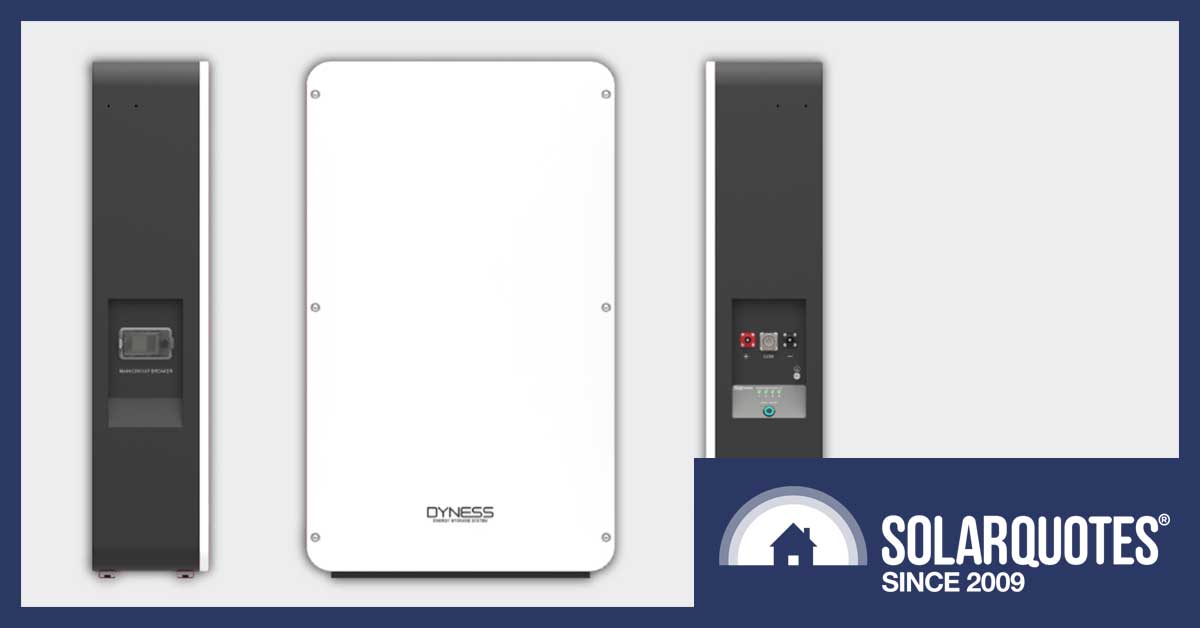
The Dyness Powerbox home battery.
There’s a new battery contender in town – the Dyness Powerbox. And if you live in SA it’s eligible for South Australia’s hefty home battery subsidy. Finn tells me it looks a lot like a Tesla Powerwall 2, but I don’t see it myself and I’m going to defend the Powerbox by pointing out all the ways it doesn’t resemble a Powerwall. For one thing, it’s got rounded corners.
Also, unlike the Powerwall 2, the Dyness Powerbox1 doesn’t contain a battery inverter and so requires a compatible hybrid inverter to work. This contender is just a container that holds up to 4 battery modules. Each module has:
- 2.4 kilowatt-hours nominal capacity
- 2.16 kilowatt-hours usable capacity
- 1.2 kilowatts continuous power output
- $1,200 subsidy in South Australia
When 4 modules have their powers combined into a fully loaded Dyness quad module Powerbox, it will have:
- 9.6 kilowatt-hours nominal capacity
- 8.64 kilowatt-hours usable capacity
- 4.8 kilowatts continuous power output
- $4,800 subsidy in South Australia2
The battery’s chemistry is lithium iron phosphate (LiFePO₄) which is the lithium chemistry most able to handle misuse.
Its operating temperature is from 0 to 50ºC. This is a good for a lithium battery and suitable for most of Australia.
Its warranty promises modules will retain 70% of their original capacity until 10 years have passed or they have provided 6,700 kilowatt-hours. Whichever comes first. This means a household would have to use an average 0.76 full cycles3 or less per day for the batteries to retain the 70% capacity warranty for 10 years.
If you are in in South Australia and want a subsidised Dyness Powerbox, they can only be obtained from one provider at the moment — Target Solar. If you’re not in SA another provider I know of is Sealed Performance Batteries or SPB for short.
Update 18 Nov 2019: Another supplier of the Dyness Powerbox is Solar Energy Warehouse.
Tech Specs
Here are technical specifications for the Dyness Powerbox lifted straight from its brochure:
I’ll go into some of these numbers in more detail and explain why — if you care about keeping your warranty — many of them are irrelevant.
Storage Capacity
Each module has a nominal storage capacity of 2.4 kilowatt-hours, but the warranty limits the maximum depth of discharge to 90%. This makes their usable storage capacity 2.16 kilowatt-hours when new. This comes to to a total of 8.64 kilowatt hours when a Powerbox is maxed out with 4 modules.
If more energy storage is needed, multiple Powerboxes can be used. While Dyness says there is no limit, I think the average inverter will have problems handling a limitless number of Powerboxes.
Power Output
Energy stored is given in kilowatt-hours but power is kilowatts. If you need to check out the difference between the two, Finn bangs on about energy vs. power here.
The maximum power output for each module given in the tech specs is 2.4 kilowatts. However the warranty states:
This means, in normal use, the power the module can supply or be charged with is 1.2 kilowatts. The maximum continuous power output for a 4 module Powerbox will be 4.8 kilowatts.
Indoors Or Outdoor Installation
The Powerbox has an Ingress Protection (IP) rating of 65:
This means it can be located out in the rain without problem. But flooding is a problem, so keep that in mind if it’s on the cards. Because heat is not good for batteries I definitely recommend locating it out of sunlight. According the warranty they cannot be exposed to temperatures over 60 degrees. Fire safety is also a consideration whether it’s located indoors, outdoors, or pretty much anywhere in Australia.
Dimensions And Weight
I’ve mentioned that some people — or some person — think the Powerbox is attempting to look like a Tesla Powerwall, but no one can deny from the front it looks considerably smaller:
But because the Powerbox is thicker, the volume of the Powerwall 2 is only 25% more:
- Dyness Powerbox volume = 108 litres
- Tesla Powerwall 2 volume = 135 litres
Because the Powerwall 2 has more storage capacity (13.5 kilowatt-hours when new) than a maxed out Powerbox, it wins on litres of volume per kilowatt-hour of usable capacity:
- 4 module Dyness Powerbox volume per usable kilowatt-hour = 12.5 litres
- Tesla Powerwall 2 volume per usable kilowatt-hour = 10 litres
As the Powerwall 2 contains a battery inverter and an active cooling system while the Powerbox is just batteries, the lithium iron phosphate battery cells inside obviously take up more space than the NMC (Nickel Manganese Cobalt) cells used by Tesla’s Powerwall 2.
While the Powerbox’s smaller size is not impressive given it’s lower capacity and functionality, it still counts as a difference in appearance from the Powerwall 2. I’m even going to make a list of all the ways its appearance is different:
“Oh Dyness Powerbox, how art thou different from a Powerwall 2? Let me count the ways…”
- Smaller
- Fatter
- Rounded corners
- Six visible holes for bolts or whatever type of fasteners it uses
See, Finn? They’re nothing alike!
Compatible Inverters
Dyness provides a long list of inverters they say are compatible with the Powerbox and list them in an order that’s not at all alphabetical:
- Goodwe — China
- Victron — Netherlands
- Solis — China
- Imeon — France
- Luxpower — China
- Growatt — China
- GMDE — China
- Sofar — China
- Voltronic — China
- Ningbo Deye — China
If your response is,
“I’ve never heard of some of those inverters!”
I would say,
“Join the club!”
I’ve put the location of their headquarters or where I know their manufacturing is done next to the names. As you can see, a whole lot of inverters are being made in China.
Dyness says more compatible inverters will be announced in the future. I’ve noticed battery manufacturers always say this, but it doesn’t always happen.
Backup Depends On Inverter
What kind of backup power, if any, the Powerbox will be able to provide depends on the inverter it’s connected to. Generally speaking, it’s possible to get almost instantaneous changeover to battery power in a blackout as well as the ability to charge the Powerbox from solar panels when the grid is down. With a suitable inverter they can be used entirely off-grid.
Operating Temperature
In its tech specs the operating temperature range is given as -20 to 50 degrees, which is excellent. Unfortunately, that’s not what the warranty allows. It states:
While this will no doubt disappoint anyone planning to use it in the (not very) Snowy Mountains or the Australian Antarctic Territory, it’s still a good operating range for Australia. Because it says “operating environment” I am going to assume it means air temperature. If it’s battery temperature that’s very different as they heat up from energy losses when charging and discharging. The good news is other lithium iron phosphate batteries are able to operate in air temperatures of up to 50 degrees, so it’s likely the Powerbox modules can do the same.
Battery Efficiency May Be 95%
The tech specs don’t give the battery round trip efficiency, but information I’ve acquired puts it at 95%. That’s not bad, but it’s only for charging and discharging the battery and doesn’t include inverter or other losses.
Warranty
The tech specs say the battery can be cycled 6,000 times, but looking at the small print…
…reveals this only is when the battery is treated like a little baby. It has to be:
- Kept at a constant 25 degrees
- Charged and discharged at a mild 480 watts per module
- Discharged to a depth of only 80%
But if the battery is treated this gently, the warranty doesn’t care and won’t cover that many cycles. What it will cover is 3,650 full cycles or 10 years. Whichever comes first. Fortunately, for most homes, 10 years should come first.
Using the average of 365.25 days in a year, the maximum amount of stored energy that can be provided while remaining in warranty is:
- Per module: 8,766 kilowatt-hours
- For a 4 module Powerbox: 35,064 kilowatt-hours
Because most households fully cycle their batteries less than once per day and because the battery capacity will deteriorate over time, this amount is unlikely to be reached inside of 10 years.4
Warranted Remaining Capacity — There’s A Trick To It
Like almost every home and business solar battery,5 its warranty promises it will maintain a specific percentage of its original capacity. But the Dyness Powerbox does it in a weird and, I think, unfortunate way.
The warranty promises the battery will retain at least 70% of its original capacity until 10 years pass or it has provided 6,700 kilowatt-hours. This is only three quarters of the 8,766 kilowatt-hours of energy output its warranty covers.
This means for the warranty to still cover it having 70% of its original capacity for the full ten years the average amount of stored energy that can be used each day would be only:
- 1 module: 1.83 kilowatt-hours
- 4 modules: 7.34 kilowatt-hours
That is an average of 0.76 full cycles per day. Many households could reach this point before the 10 year warranty maximum is reached and so have a period where the battery modules would still be under warranty, but with no promised minimum amount for remaining battery capacity.
This is an odd warranty. I presume they are not confident the batteries will still be at 70% of their original capacity after 10 years but didn’t want to have either a minimum promised capacity of under 70% or warranty of less than 10 years, so Dyness went with this weird solution. I don’t like it as it makes the warranty harder to understand and makes it more difficult to compare with other battery warranties. I hope they will improve it, or at least make it simpler.
I suppose many households would still use an average of less than 0.76 full cycles per day and so the Powerbox will end up warranted to have at least 70% of its original capacity for 10 years. But if you plan to use your battery at high capacity, watch out for this.
Dyness Doesn’t Understand Temperature
Lithium iron phosphate is the most stable lithium battery chemistry, but that alone is not enough to make it safe. If it’s not part of a well designed system then any lithium battery is dangerous and all are capable of catching on fire, venting flames, spewing toxic gases, and — if tightly confined as battery cells usually are — exploding. None-the-less, Dyness makes a big deal of lithium iron phosphate (LiFePO4) batteries’ safety:
Wait, what was that? Say that middle bit again!
No it’s not! It’s not 100% higher! Dyness even provide a graph that contradicts this:
This is a graph of the Temperature Range of Decomposition, which is a fancy way of saying “at these temperatures the shit starts to hit the fan and the fan is made of explosions”.
If we look at the lower ends of the bars on the graph, the temperature at which the blue bar of the LMO battery starts to get explody is almost half the degrees Celsius figure of the green lithium iron phosphate (LFP) bar, but that is not a 100% higher temperature.
The freezing point of water was chosen as zero for Anders Celsius’s temperature scale because that’s convenient for humans,6 not because temperature starts at zero Celsius. It starts at absolute zero which is -273.15 degrees Celsius.7 This is zero on the Kelvin scale which is something Lord Kelvin came up with in between inventing the Kelvinator and working out the first two laws of thermodynamics.
I’ll fix Dyness’s graph for them so temperature starts where it should:
That’s better. Now we can see that lithium iron phosphate batteries start to get explody when their temperature is about 46% higher than the next most stable battery chemistry, not 100%.
Dyness — The Company
Dyness is located in Yangzhou City in Jiangsu Province in China. Yangzhou City is famous for its Slender West Lake and for not quite being in the top 29 most polluted cities in China.

Slender West Lake: Now dissolving statistically fewer swimmers. (Image: Wikipedia Commons)
I haven’t found any evidence of Dyness existing before 2017. Although it’s a young company I’m not going to hold that against them and I’m happy to wait and see what they can do. It’s only if companies screw up that I mock them relentlessly and mercilessly.
But we can be sure their Research & Development department has some real smarts behind it, as this passage from their website demonstrates:
Thank god they didn’t have to share a laboratory with one of those abnormal universities. I’ve seen enough monster movies to know that could have been disastrous.
The Dyness website also tells us how great their Powerbox is:
If they can do that and combine it with a better warranty, they should be onto a winner. After all, who doesn’t like top class quality at an affordable price? It’s amazing how few companies think of providing both of these things at the same time. It’s almost as if they’re not really trying to succeed in business.
No Dyness Australian Office
Dyness does not have an office in Australia. This means its importer has responsibility for the manufacturer’s warranty while the business you purchased it from still has all its obligations under Australian consumer law.
But Australia is important to Dyness because on their world map Australia has 4 out of 21 dots:
That means we’re in possession of 19% of Dyness’s map dots and that’s got to count for something. Unless it doesn’t.
Availability And Price
If you’re in South Australia and want a Dyness Powerbox, the only place you can get one and receive the state’s subsidy at this time is Target Solar. The subsidy is $1,200 per module or $4,800 for a Powerbox stuffed to the brim with 4 of them, so chances are you’re not going to want to miss out on it.
If you’re not after the SA subsidy, then Sealed Performance Batteries (SPB) is another provider of the Powerbox. Based on information they gave, my estimate of the price of a Dyness Powerbox with 4 battery modules and 8.64 usable kilowatt-hours of storage is around $8,900. This is before installation and doesn’t include a hybrid inverter.
SPB told me they have been using a 5 kilowatt Luxpower inverter with the Dyness Powerbox. This inverter is new in Australia and I was told it can provide full backup and accept up to 8 kilowatts of solar panel capacity. This is useful for people who are getting both solar and a battery installed at the same time, as STCs — usually referred to as the “solar rebate” — can be claimed for the full 8 kilowatts when a battery is being installed as well, rather than the usual maximum of 6.66 kilowatts for a 5 kilowatt inverter. My price estimate for a this Luxpower hybrid inverter is around $2,600. Again, this is before installation.
The people who will get the most bang for their buck from a Dyness Powerbox will be those installing a new solar power system with 8 kilowatts of panels.
Wallet Warning
In case you didn’t know, I’ll mention home batteries won’t pay for themselves at the moment unless there are special circumstances. This is generally the case even with South Australia’s big fat subsidy. So if your motivation is to save money, be very cautious and maybe keep an eye out for useful offers from Virtual Power Plants.
But if you’re not worried about losing money, then can I borrow some? I only need enough to get me through Christmas and possibly purchase a small castle.
Footnotes
- Update 25th January 2024: The Dyness Powerbox has been discontinued and replaced with the Dyness Powerbox Pro. ↩
- Or $5,760 for those who receive the SA Energy Concession, such as pensioners and most people who receive Centrelink payments. But if you are in this group you’ll need to be especially careful making sure you don’t end up losing money on the deal. ↩
- A full cycle is equal to the nominal capacity of 2.4 kilowatt-hours per module. Partial cycles — and they all will be partial cycles — are summed together to determine the number of full cycles. ↩
- You may want to join a Virtual Power Plant (VPP) and it is unclear how much extra use these will typically place on batteries at the moment, so the more stored energy the warranty covers the better. ↩
- Looking at you, Sonnen. ↩
- Anders Celsius didn’t choose the freezing point of water to be zero. He instead made the boiling point of water 0 and the freezing point 100. This is because it doesn’t matter how much of a genius you are, a lot of the time you’re still going to be an idiot. As soon as he was dead a more sensible person — a French serial killer — changed it around. ↩
- Oh, alright. -273.16 degrees then. First you take the planet Pluto from me and now you take my absolute zero. What’s next? Scientific proof that my beard isn’t sexy? ↩

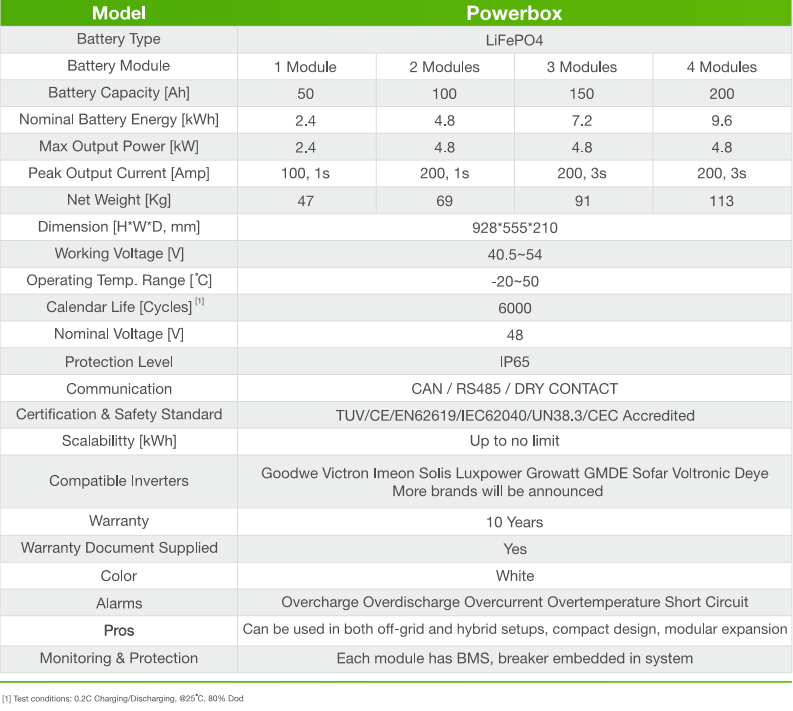
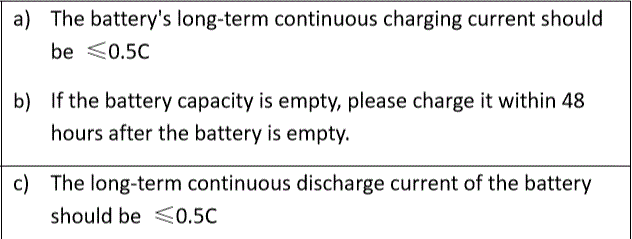

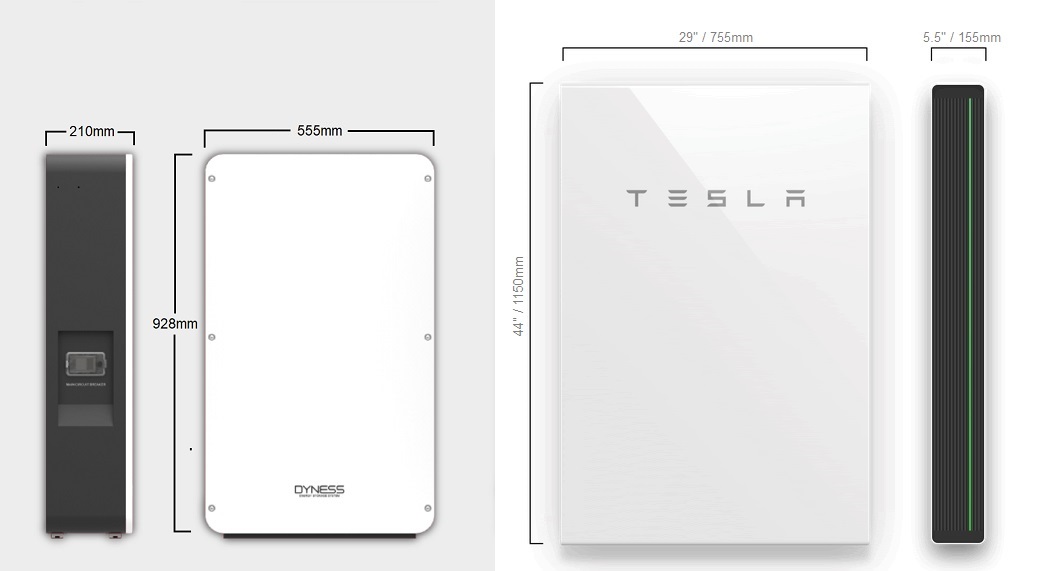


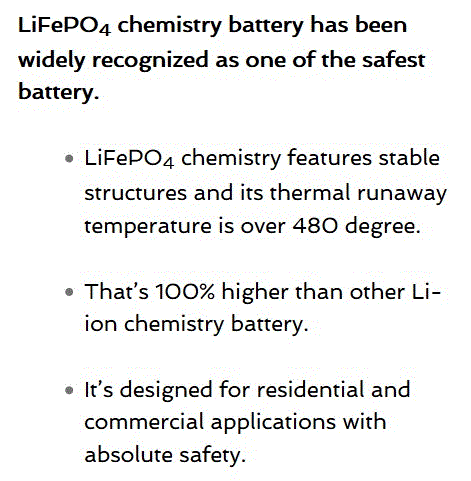
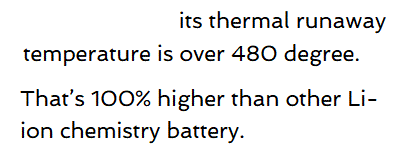
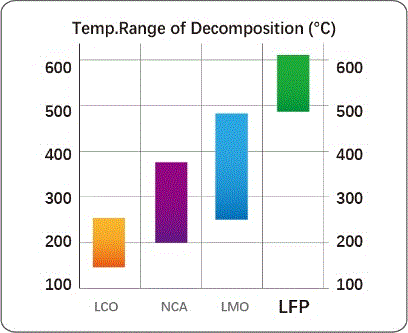

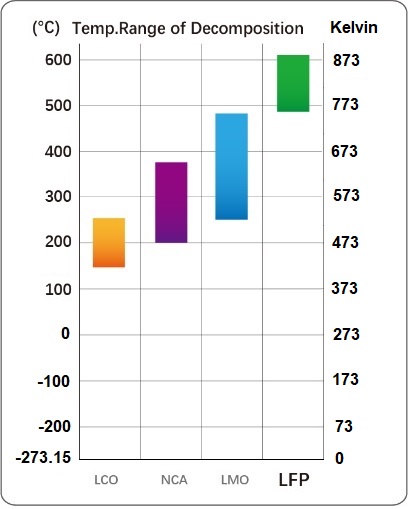



 RSS - Posts
RSS - Posts



Please do not refer to Lithium Iron Phosphate (LiFePO4) batteries as just Lithium Iron!!!
It is all too easy to confuse this chemistry with other Lithium Ion batteries, and this would only exacerbate that confusion.
If you want to shorten the name somehow, just use LFP.
I have no problem because the words iron and ion taste very different to me, but I guess for those weird people who go by how words sound it could be very confusing. Good point.
UPDATE: Article has been improved as per your suggestion. It’s now lithium iron phosphate all the way.
Hey Ron,
Is it mentioned of the Dyness Battery Wall are able to be stacked.
2 Dyness Powerbox with the combined capacity of of 17.28Kwh or
3 Dyness Powerbox with the combined capacity of of 25.92Kwh
would be interesting to compare considering the price differences.
As cost comparison go:
Dyness Powerbox: $8,900
LG CHEM 9.8kWh LV (RESU 10LV): $8,999.00 (2 max combined)
BYD B-Box 10kWh Package : $9,000
Tesla Power Wall: $12,000
While most people wouldn’t be as interested, as a off-grid person this would be interesting.
You missed the part that the University they partnered with is actually a Teaching College ? Maybe they needed some Lab space. I was also told as fact from an importer that it was former partners in Pylontech that broke away and formed Dyness. The modules are almost identical.
I wonder how they arrange the batteries to power the inverters?
Many inverters accept nominal 48v input, i.e. a stack of four 12v lead-acid or LiFePO4 batteries, but the 12v LiFePO4 batteries I’ve looked at can only be stacked to 24v. After that, equalisation becomes a serious problem. That has caused me to shy away from them so far.
Hi, like the detail this goes into.
Just wanted to double check and understrand the math in “Warranted Remaining Capacity — There’s A Trick To It”.
> This is only three quarters of the 8,766 kilowatt-hours of energy output its warranty covers.
Your 8,766 kilowatt-hours number you use is based simply on a product of nominal capacity x days in 10 years (10 * 365.25 * 2.4)?
But as I understand it, given the battery health ages with every cycle, not sure it’s correct to just take the nominal capacity an do a simple multiplication of the over 10 years. They clearly state the batteries depth of discharge is only 90% (as is many other LFP batteries, e.g. Pylontech). One has to factor in daily/cyclic aging and it’s affect over 10 years?
If we drew the usable capacity on a graph over 10 years and assumed linear degradation, then a linear downward sloping line of ~3% loss per year (30% loss after 10 years) means each day delivers slightly less Wh per day.
My math literacy is not the best, but if I attempt an “area under the graph” integral calculation considering the usable capacity loss/health over time, I end up at the same 6.7MWh (per module) or 26.8MWh for the powerbox.
f(x) = (usable_capacity_old_10_yr_w – usable_capacity_new_w)x = -0.17753424657534247x
Where:
– usable_capacity_new_w = nominal_capacity_w * max_depth_of_discharge = 2160
– usable_capacity_old_10_yr_w = nominal_capacity_w * warranty_capacity_health_10yr * max_depth_of_discharge = 1512
If we manage to get data from an inverter, one can double check the assumption that health degradation is roughly linear, and also, use a Trapezoidal rule to estimate the area under the graph (don’t claim to know the detailed math, just know this is a useful function in python programming to estimate area under a curve from a data table)
See https://en.wikipedia.org/wiki/Trapezoidal_rule
As an aside – Yangzhou is actually famous for its fried rice – at least in China!
Dyness also seems to be selling these in the other SA (South Africa), pricing seems to be relatively decent in rands, at least compared to the competition (which is mostly Pylontech).
Does anyone have the prospective fault current for each module B4850 ? I’ve scoured the user manual(s) & MSDS as well as google & youtube for reliable answers with no success ( so far )